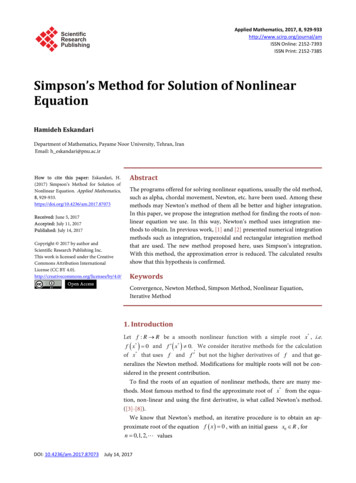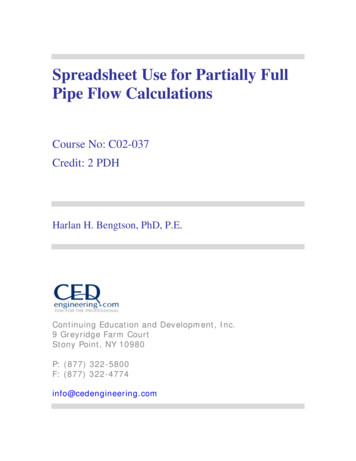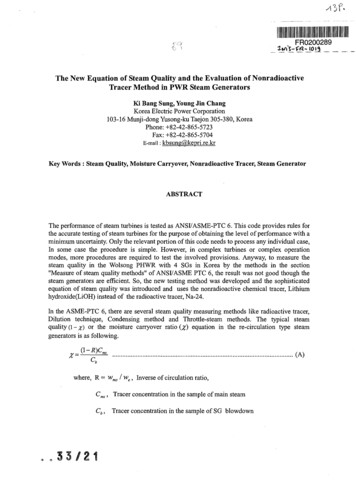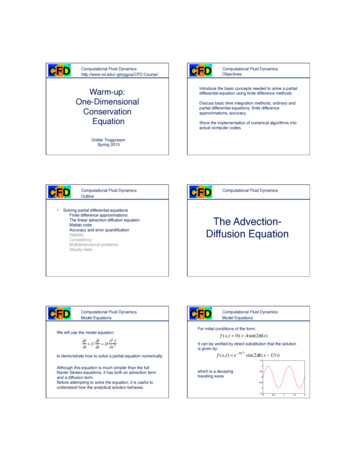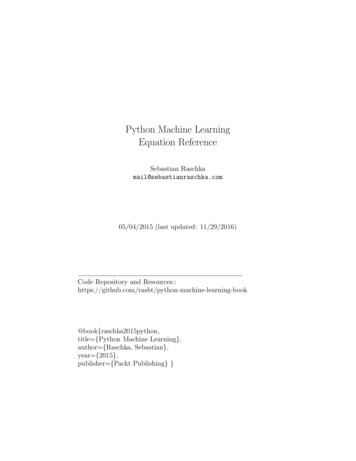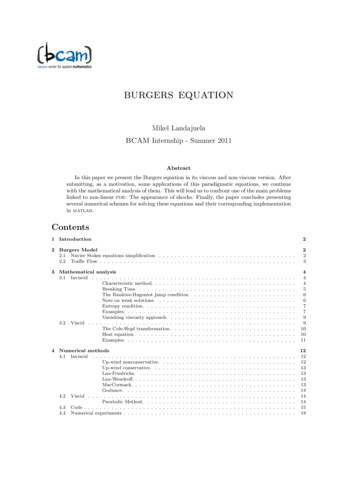
Transcription
burgers equationMikel LandajuelaBCAM Internship - Summer 2011AbstractIn this paper we present the Burgers equation in its viscous and non-viscous version. Aftersubmitting, as a motivation, some applications of this paradigmatic equations, we continuewith the mathematical analysis of them. This will lead us to confront one of the main problemslinked to non-linear pde: The appearance of shocks. Finally, the paper concludes presentingseveral numerical schemes for solving these equations and their corresponding implementationin matlab.Contents1 Introduction22 Burgers Model2.1 Navier Stokes equations simplification . . . . . . . . . . . . . . . . . . . . . . . . . . . . . . . . . . .2.2 Traffic Flow . . . . . . . . . . . . . . . . . . . . . . . . . . . . . . . . . . . . . . . . . . . . . . . . . .2233 Mathematical analysis3.1 Inviscid . . . . . . . . . . . . . . . . . . . . . . . . . .Characteristic method. . . . . . . . . . .Breaking Time. . . . . . . . . . . . . . .The Rankine-Hugoniot jump condition.Note on weak solutions. . . . . . . . . .Entropy condition. . . . . . . . . . . . .Examples. . . . . . . . . . . . . . . . . .Vanishing viscosity approach. . . . . . .3.2 Viscid . . . . . . . . . . . . . . . . . . . . . . . . . . .The Cole-Hopf transformation. . . . . .Heat equation. . . . . . . . . . . . . . .Examples. . . . . . . . . . . . . . . . . .44456677991010114 Numerical methods4.1 Inviscid . . . . . . . . . . . . . . . . . .Up-wind nonconservative.Up-wind conservative. . .Lax-Friedrichs. . . . . . .Lax-Wendroff. . . . . . . .MacCormack. . . . . . . .Godunov. . . . . . . . . .4.2 Viscid . . . . . . . . . . . . . . . . . . .Parabolic Method. . . . .4.3 Code . . . . . . . . . . . . . . . . . . . .4.4 Numerical experiments . . . . . . . . . .121212131313131414141518.
1INTRODUCTION12IntroductionIn this paper we will consider the viscid Burgers equation to be the nonlinear parabolic pdeut uux uxx(1)where 0 is the constant of viscosity. This is the simplest pde combining both nonlinearpropagation effects and diffusive effects. When the right term is removed from (1) we obtain thehiperbolic pdeut uux 0.(2)We will refer to (2) as the inviscid Burgers equation. Note that equation (2) can be rewritten inthe formu2,(3)ut [f (u)]x 0 with f (u) 2where is easily recognizable the structure of a scalar hiperbolic conservation law. Many of theideas presented in this paper (relating to mathematical treatment, numerical methods,.) can beformulated in the framework of the theory of scalar hiperbolic conservation laws so for generality we will often refer to (2) in the form (3) and the developments will be valid for a general f in (3).There is an important connection between the above equations: Equation (2) is the limit as 0of (1). This is true from the formal point of view but also in the most rigorous sense. This factwill be studied in more detail in the paragraph called Vanishing viscosity approach.2Burgers ModelBurgers equations appear often as a simplification of a more complex and sophisticated model.Hence it is usually thought as a toy model, namely, a tool that is used to understand some of theinside behavior of the general problem. Here we will present two examples.2.1Navier Stokes equations simplificationConsider the Navier Stokes equations · v 0,(4.1)(ρv)t · (ρvv) p µ 2 v 0. (4.2)(4)It is well known that when ρ is consider to be the density, p the pression, v the velocity and µ theviscosity of a fluid, equations (4) describe the dynamics of a divergence free (4.1) incompressible(ρt 0) flow where gravitational effects are negligible.Simplification in (4.2) of the x componet of the velocity vector, which we will call v x , gives 2 x xxx p v 2 vx 2 vx v xx vy vz vρ ρv ρv ρv µ 0. t x y z x x2 y 2 z 2If we consider a 1D problem with no pressure gradient, the above equation reduces toρ v x v x 2 vx ρv x µ 0. t x x2(5)If we use now the traditional variable u rather than v x and take to be the kinematic viscosity,i.e, µρ , then the last equation becomes just the viscid Burgers equation as it has been presented
2BURGERS MODEL3in (1).When the viscosity µ of the fluid is almost zero, one could think, as an idealization, to simplyremove the second-derivative term in (5). This would lead toρ v x v x ρv x 0 t x(6)which, after making u v x and dividing by ρ, becomes the inviscid Burgers equation as it is shownin (2). It turns out that, in order to use (6) as a model for the dynamics of an inviscous fluid, ithas to be supplemented with other physical conditions (section 3.1) which will prevent equation(6) from developing physical meaningless solutions. This extension is worth because working with(6) is much easier than dealing with (5).2.2Traffic FlowConsider the flow of cars on a highway and let ρ(x, t) denote the density of cars and f (x, t) thetraffic flow. We will also consider ρ to be the restriction of ρ to a certain range, 0 ρ ρmax ,where ρmax is the value at which cars are bumper to bumper.Since cars are conserved, the density of cars and the flow must be related by the continuityequation f ρ 0.(7) t x Obviously, the first expression in which one thinks for the flow is f vρ where v is the velocity.However, it turns out that in order to reflect the fact that drivers will reduce their speed to accountfor an increasing density ahead we should suppose that f is a function of the density gradient aswell. A simple assumption is to takef (ρ ) ρ v(ρ ) D ρ where D is a constant. x (8)We are assuming also that the velocity v is a given function of ρ : On a highway we wouldoptimally like to drive at some speed vmax (the speed limit perhaps) but with heavy traffic we slowdown, with velocity decreasing as density increases. The simplest relation that is aware of this isv(ρ ) vmax(ρmax ρ ).ρmax(9)Putting (8) and (9) into (7) leads to ρ 2d vmax ρ (ρ ρ)ρ D .max t dx ρmax x 2Scaling through vmax x0t0 ,(10)ρ ρmax ρ , x x0 x and t t0 t results inρt [(1 ρ)ρ]x ρxx with Dvmax x0and 0 ρ 1.(11)The transformation u 2ρ 1 leads to the viscid Burgers equation as it is shown in (1) with theconditions 1 u 1.
3MATHEMATICAL ANALYSIS34Mathematical analysisFrom the mathematical point of view Burgers equations are a very interesting and suggestive topic:It turns out that a study of them leads to most of the ideas that arises in the field of nonlinearhiperbolyc waves.3.1InviscidWe will focus first on equation (2). Specifically, we will deal with the initial value problem ut uux 0,x R, t 0,u(x, 0) u0 (x), x R.(12)As it as has been suggested previously, although (12) seems to be a very innocent problem a prioriit hides many unexpected phenomena.Characteristic method. The similarity with the advection equation suggests considering, asa first approach to solve (12), the characteristic method. In this case the characteristic equationwould be 0x (t) u(x(t), t), t 0,(13)x(0) x0 .If x(t) and u(x, t) ( C 1 ) are solutions of (13) and (12) respectively, thend[u(x(t), t)] ut (x(t), t) x0 (t)ux (x(t), t) ut (x(t), t) u(x(t), t)ux (x(t), t) 0,dti.e, u is constant along the characteristic curve x(t) and thereforeu(x(t), t) u(x(0), 0) u0 (x0 ),(14)which considering the sistem (13), leads to conclude that the characteristic curves are straight linesdetermined by initial data :x x0 u0 (x0 )t, t 0.(15)In principle, one could invert (15) to obtain x0 x0 (x, t). Then, using (14), one would obtain thesolution u(x, t) u0 (x0 (x, t)). However, as the required inversion usually can not be accomplishedanalytically, one could use a symbolic calculation program to construct a discretized solution of(12) by dragging the initial data u0 (x0 ) along the characteristic line (15). This strategy is followedby the following program in mathematica:Clear[f0, fval, x, f]f0[x ] Exp[-(2 (x - 1)) 2];(*Condición inicial*)x[t , x0 ] x0 f0[x0] t;f[t , x0 ] f0[x0];fval[t ] : Table[{x[t, x0], f[t, x0]}, {x0, -.5, 3, .1}](*Dibujo de las caracterı́sticas*)Plot[Table[x[t, x0], {x0, -.5, 3, .1}], {t, 0, 2},AxesLabel - {Text[Style["t", Italic, 23]],Text[Style["x", Italic, 23]]}](*Dibujo de la solución u(x,t)*)ListPlot3D[{Table[Table[{x[t, x0], t, f[t, x0]}, {x0, -.5, 3, .1}], {t, 0, 2, 0.1}]},
3MATHEMATICAL ANALYSIS5ColorFunction - "DarkRainbow", PlotStyle - Directive[Opacity[0.9]], MeshFunctions - {#2 &},Mesh - 5, PlotRange - All, Axes - {True, True, True} ,Boxed - False, ImageSize - 600,AxesLabel - {Text[Style["x", Italic, 23]],Text[Style["t", Italic, 23]], Text[Style["u", Italic, 23]]}]2Figure 1: Output of the programme for u0 (x) e (2(x 1)) . Some characteristic lines are presentedin the first picture.Looking to this example one quickly finds that problem (12) exibits (under certain initial conditions) what is called the wavebreaking phenomenon: The peak of the pulse moves the fastestbecause wave speed increases with increasing amplitude. This can also be understood by lookingto the corresponding slope of the characteristic line in the (x, t) plane. Eventually the peak overtakes the rest of the pulse, or the characteristic cross with another one, and the solution becomesmultiple valued. The time value tB at which this happens for the first time is called the breakingtime.Breaking Time. In order to determine the breaking time, let us consider two characteristicsthat arise from initial conditions x1 and x2 x1 x. According to (15), these characteristicswill cross whenx1 u0 (x1 )t x2 u0 (x2 )t.Solving for t leads tot x1 x2 x .u0 (x1 ) u0 (x2 )u0 (x1 ) u0 (x1 x)(16)1When x 0 then the time in (16) converges to t u0 (x. To find the breaking time tB we1)0find the minimum (positive) value for t, 1.tB min 0x Ru0 (x)Although the solution obtained via the characteristic method seems to be valid for t tB , itis clear that mathematically multiple valued solutions in a region is unphysical in most of thesituations (think of u as density) so it can not be accepted for t tB . What is then the solution
3MATHEMATICAL ANALYSIS6of (12) after the breaking time? This question is in the basis of what is called the shock-fittingproblem:The only way to establish a solution after the breaking time is to allow discontinuities of u. Suchdiscontinuity is called a shock. This requires some mathematical extension of what we mean by asolution to (12), since strictly speaking the derivatives of u will not exist at a discontinuity. It canbe done through the concept of a weak solution. However, by expanding our class of solutions toinclude discontinuous solutions, we can no longer guarantee the uniqueness of the solution to (12).The nonuniqueness can be resolved only by appeal to physically inspired criteria. More specifically,we need some shock conditions relating the jumps of u across the discontinuity.The Rankine-Hugoniot jump condition. The Rankine-Hugoniot jump condition determinesthe position of a shock at a given time. This condition emerges when one consider the equation(3) in integral form by integrating respect to x over x2 x x1 ,Zd x1u(x, t) dx f (u)xx12 0.(17)dt x2The physical background is clear, the equation (17) is the traditional form of a conservation law:The rate of change of the total amount of u in any section x2 x x1 must be balanced by thenet inflow across x1 and x2 . Suppose now that there is a discontinuity at x s(t) and that x1and x2 are chosen so that x2 s(t) x1 . Suppose u and its first derivative are continuous inx1 x s(t) and in s(t) x x2 , and have finite limits as x s(t) from above and below.Then, if we assume (17) we have:f (u)x2 f (u)x1 ddtZZs(t)u(x, t) dx x2s(t)u2 ṡ u1 ṡ ZddtZx1u(x, t) dx s(t)x1ut (x, t) dx ut (x, t) dxs(t)x2where u2 , u1 are the value of u as x s(t) from below and above respectively and ṡ s0 (t).Since ut is bounded in each of the intervals separately, the integral tend to zero in the limit asx1 s , x2 s and, therefore,f (u)2 f (u)1 (u2 u1 )ṡ.Note that the argument above is valid for a general hiperbolic conservation law of the formut [f (u)]x 0. If we focus on equation (3) we obtainṡ f (u)2 f (u)1 u2 u1122 u2 12 u1 21 (u1 u2 )u2 u12(18)This is the first condition that the shock of our discontinuous single valued solution will have tosatisfy.Note on weak solutions. In this section we will work within hiperbolic conservation laws, i.e.,as it has been told in the introduction, equations in the formut [f (u)]x 0(19)
3MATHEMATICAL ANALYSIS7with some f (see (3)). Mathematically, a discontinuous solution with continuously differentiable(u)1parts satisfying (19) and such that ṡ f (u)u22 fcan be considered a weak solution of (19). As u1a motivation for the idea, let φ(x, t) be an infinitely smooth function in R [0, ) that vanisheson the boundary. Let u(x, t) be a smooth solution of the hyperbolic conservation law given. ThenZ Z Int. by parts(φut φ [f (u)]x ) dxdt 0 0Z (φu 0 dx Z0 Z (φf (u) dt Z Z Z (φt u φx f (u)) dxdt0φ 0 on bound. (φt u φx f (u)) dxdt0 In view of this development it is natural to say that u(x, t) is a weak solution of the conservationlaw if for any φ(x, t) the
2.1 Navier Stokes equations simpli cation Consider the Navier Stokes equations ˆ rv 0; (4:1) (ˆv) t r(ˆvv) rp r2v 0: (4:2) (4) It is well known that when ˆis consider to be the density, pthe pression, v the velocity and the viscosity of a uid, equations (4) describe the dynamics of a divergence free (4.1) incompressible (ˆ t 0)

![[EPUB ] The Bob's Burgers Burger Book: Real .](/img/6/the-bob-039-s-burgers-burger-book-real-recipes-for-joke-burgers.jpg)




